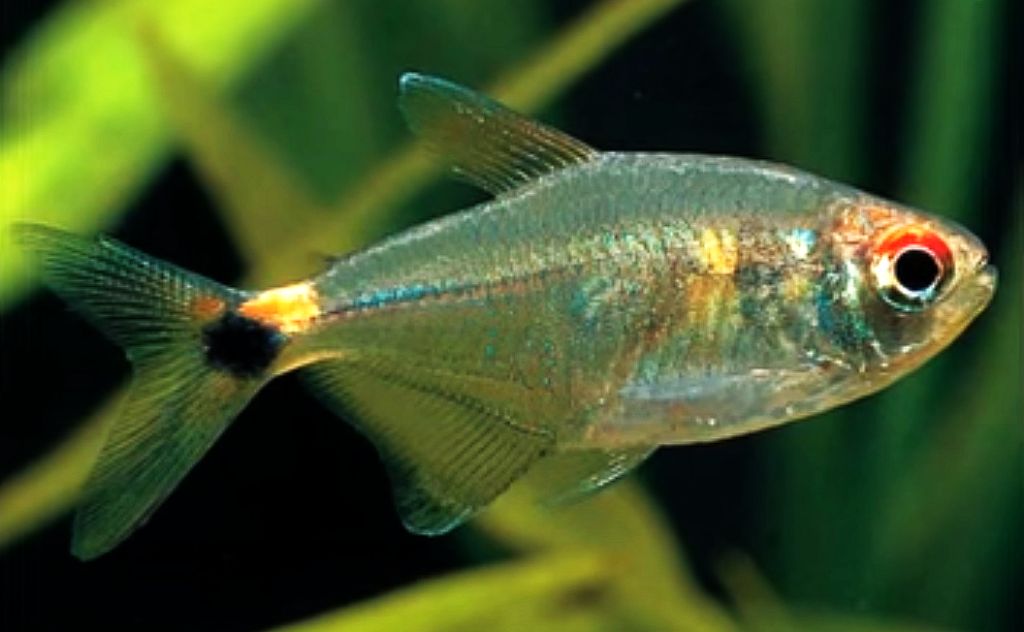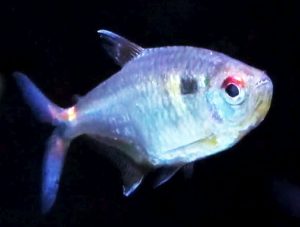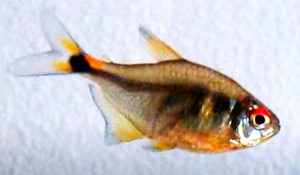The Head and Tail Light Tetra (Hemigrammus ocellifer) known to tropical fish keeping enthusiasts as the Beacon Fish originates in South America in the Amazon and Orinoco River basins, parts of Guyana, Suriname, French Guiana, Peru and Brazil. Because of its popularity with tropical fish keeping enthusiasts worldwide, they are bred in huge numbers for the aquarium trade.
Head and Tail Light Tetras are a peaceful shoaling species that prefer slow moving rivers, streams, and floodplain lakes.
The Head and Tail Light Tetra’s body is compressed, oval in shape, and an iridescent silver color. The rear part of the body and fins are almost translucent. It gets its common name from the two reflective black spots surrounded by copper coloring at the base of the tail and next to the gill cover that resemble auto headlights.
A fine black line starting mid body runs to the black spot at the base of the caudal fin. The upper part of their black and yellow eye is ringed in red and looks similar to Redeye Tetras.
Adult males when viewed from above are smaller and thinner than females. Females are generally larger and more heavily bodied than males. They can be sexed by examination of the swim bladder, that is visible through the translucent skin. In males the swim bladder tapers to a point. In females, it is more rounded.
A similar but more slender species, Hemigrammus ocellifer falsus, has the taillight spot, but lacks the second spot behind the gill cover.
Head and Tail Light Tetras do best in schools of 6 or more individuals and can be housed with other peaceful tetras, barbs, danios, rasboras, and several other small to medium sized fish in a community tank environment. Small loaches, catfish, dwarf cichlids, and dwarf gourami are also suitable tank mates but avoid large fish and slow moving, long finned species like bettas and angelfish.
The Head and Tail Light Tetra is a perfect candidate for a black water biotope setup. They are best housed as a shoal of 10 or more of their own kind in a planted tank of at least 20 gallons with a river sand or fine gravel substrate, some driftwood branches and some dried Indian Almond
, Beech, or Oak leaves to replicate their natural waters. A peat bag added to the filtration system can be substituted to simulate the weak tea colored conditions that they are found in.
Some small floating plants like duckweed, can be added to provide shady spots, diffuse overhead lighting and mimic the dimly lit conditions they prefer. Frequent water changes are recommended.
Be sure to replace the dried leaves every couple of weeks, so as not to foul the aquarium water.
Head and Tail Light Tetras are relatively easy to breed in an aquarium.
Set up a breeding tank with plenty of fine leaved plants for them to lay their eggs, dim lighting, and soft, slightly acidic water. A temperature of 80 degrees F, a pH of 6.0 to 6.5, and a gH of 1-5 will do the job.
Condition several specimens with live or frozen brine shrimp,bloodworms, daphnia, etc. for a week or two, select a ripe female and the best colored male, and place them in the breeding tank. The female’s belly will swell with eggs when spawning is imminent and usually occurs in the morning hours. Over the course of a day, up to 1,000 eggs will be laid on the plants.
When spawning is over, promptly remove the parents from the tank. The eggs hatch in about 24 hours and the fry are free swimming in a couple of days. When the egg sacs are absorbed, they can be fed Infusoria, commercially prepared powdered fry food, egg yolk, etc. until they grow large enough to accept newly hatched brine shrimp or mircoworms. Because the eggs and fry are light sensitive in the early stages of life, keep the rearing tank in complete darkness if at all possible.
Head and Tail Light Tetras are omnivorous and in an aquarium environment will readily accept just about anything offered. Regular meals of live, frozen or freeze dried brine shrimp, bloodworms, small insects, and Daphnia, along with a quality dried flake food or granule will keep them in the best condition.
Head and Tail Light Tetras, also known as Beacon Tetras, are common in most tropical fish shops. It is popular, hardy, inexpensive, and one of the best choices for newcomers to tropical fish keeping. Selectively bred albino specimens have become popular in recent years and are readily available.
Minimum Tank Size: 20 gallons
Care Level: Moderate
Temperament: Peaceful
Aquarium Hardiness: Hardy
Water Conditions: 74 to 82 °F , dH 5-20, pH 5.5-7.5
Max. Size: 1.8″
Color Form: Silver, Black
Diet: Omnivore
Compatibility: Peaceful, keep with other small tetras
Origin: Amazon and Orinoco River basins
Family: Characidae
Lifespan: 5 years
Aquarist Experience Level: Beginner





